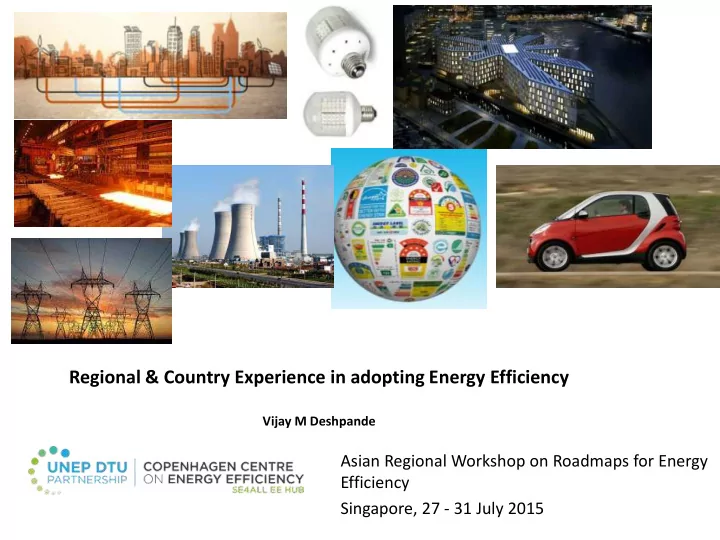

Regional & Country Experience in adopting Energy Efficiency Vijay M Deshpande Asian Regional Workshop on Roadmaps for Energy Efficiency Singapore, 27 - 31 July 2015
C2E2 Regional Studies Initiative • Work in four regions: – Asia – CIS – Africa – Latin America & the Caribbean (LAC) • A total of 52 countries were covered in four regions (Asia 5, CIS 10, Africa 24, LAC 13) • Studies in the nature of rapid assessments : – Status and initiatives on energy efficiency (EE) – Barriers to EE – Priority sectors and future opportunities in EE
Five South-East Asian Countries : Indonesia Study carried out by Malaysia Asian Institute of Philippines Technology (AIT), Thailand Thailand Vietnam Stakeheolder consultation • In-country consultation with Questionnaire survey various stakeholders to discuss EE opportunities and barriers, • Collecting information/ data and to brainstorm to identify on energy efficiency initiatives, the types of assistance policy instruments, types of Programs and Policy required. assistance required, and review existing and percieved barrriers. • Review of energy efficiency initiatives undertaken by Desk study multilaterial/bilateral • Review of relevant policy organisations, research documents, schemes and institutions, and review of legislation, and technology existing policy instruments. developments and their implementations. Methodology
Structure • Initiatives • Barriers • Priorities • Opportunities and Challenges • Consolidated View • Achievements • Support Required • Observations
Indonesia: Energy Efficiency Initiatives • Industry and transport sectors are major consumers of energy, together accounting for > 80% of total final energy consumption (2012) • Directorate of Energy Conservation, Ministry of Energy and Mineral Resources is the focal point for energy efficiency • National Energy Policy (79/2014) – Reducing energy intensity (energy use per unit of GDP) by 1% every year – Bringing energy elasticity below 1 • More than 30 years of efforts in the EE area with multiple initiatives 1982: Presidential instruction on road map for energy conservation (91/1982) 1985: Master Plan on energy conservation 2005: Mandatory energy conservation in government offices and buildings (10/2005) 2007: Law of Energy, Part 3, Article 25 deals with energy conservation (30/2007) 2009: Energy Efficiency Labeling - Air-conditioners, refrigerators, lamps´(fluorescent) and freezers Voluntary, except for lamps 2009: Regulation on energy conservation with government being made responsible for EC, preparation of National masterplan for EC 2003-20: National energy policy - appliance standards, promotion of co-generation, DSM in industry, EE standards for motors 2011-14: Presidential and/or MEMR instructions/regulations on/concerning - energy & water saving, electricity saving, energy management On-going: Master Plan preparation
Indonesia: Energy Efficiency Programs • Capacity building and training (energy auditor and manager certification) • Awareness creation (seminars, outreach events, awards, competition, guidelines) • Implementation of ISO 50001 (pilot 20, additional 4) 4 case studies show 7- 11.3% saving after 1 year of ISO 50001 • Standards and labeling • Energy audit of buildings and industries & final implementation of recommendations • DSM programs providing subsidy/free CFLs to consumers • Sustainable Tourism through Energy Efficiency with Adaptation and Mitigation Measures (STREAM) - EE approach in all tourist services in Pangandaran, wirh a view to replicate • Donor supported programs – DANIDA: support to national and regional governments in implementing and monitoring EE and RE initiatives – UNIDO industry energy efficiency program in textiles, garments, pulp & paper, food and beverages, and chemical industry sub-sectors
Barriers to EE in Indonesia
Indonesia: Sector Priorities Sectors Priority level Remarks Represents 40.5% of national consumption (2012) Will nearly double by 2035 compared to 2010 Oil is and will remain as the major fuel in this sector (96% in 2035), Transport High to medium a major concern in terms of both declining oil production and its contribution to GHG emissions Large industries and SMEs together represent 39.7% of national consumption (2012) Industrial and SMEs High to medium Expected to double by 2035 compared to 2010 Future growth in GDP will put more pressure on energy demand in this sector Very low use of new and renewable energy sources (only 4%) High potential for PV, biomass, biofuel, geothermal, micro-hydro Energy generation Medium Building sector represents 12% of national consumption Development of an energy-efficient building code will help to Building Medium to low reduce energy consumption in this sector Very low consumption Commercial Low Standard and labelling are already in place in the commercial sector
Indonesia: Opportunities & Challenges Description Assistance required Technical and High energy consumption in industrial and transportation sector. This is expected to grow in future. OPPORTUNITIES financial The government is aiming for ambitious GHG emissions reductions through the implementation of renewable energy Financial and technologies and energy efficiency. technical The government has developed guidelines for energy smart street lighting. Financial support is needed for the Financial implementation of this program. Capacity There are significant opportunities to develop the capacity of government and the public sector to provide effective EE services. development Limited domestic production of EE technologies and products. Also a lack of energy-efficient technologies in the market. Technical Technology and energy-efficient equipment in general are expensive, and the financial mechanisms needed to purchase Financial them are limited. Energy prices are relatively cheap due to energy subsidies. Policy Policies on cleaner production and sustainable consumption and production are not mandatory. Policy A lack of financial incentives, especially for SMEs. Policy CHALLENGES Policy and implementation mechanisms are not decentralized for a large country like Indonesia. None A lack of mandatory requirements for sustainable waste management is a barrier to waste-to-energy initiatives. Policy Evaluation and monitoring of energy conservation programs is weak. Institutional Capacity A lack of information and understanding of the financial and qualitative benefits. development Obtaining loans or funds for energy efficiency is a very cumbersome process. Institutional The focus of the top management of industries and companies is entirely on production. Energy efficiency is not seen as a Capacity strategic business investment. development Capacity Knowledge and capacity to implement EE measures in local government are very low. development
Recommend
More recommend